MARIANI’S
Virtual Gourmet
JUNE 7, 2015
NEWSLETTER
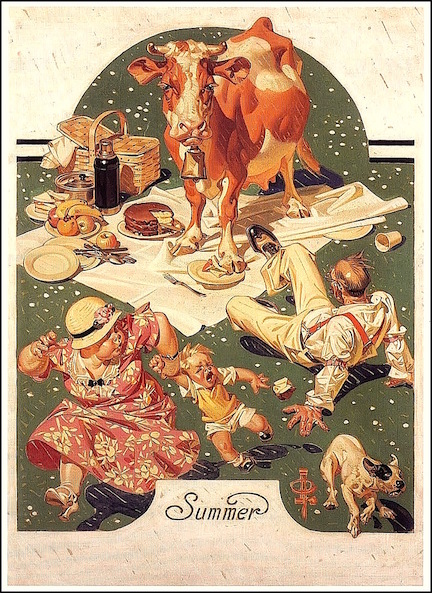
IN THIS ISSUE
Fearrington House Inn, North Carolina
By John Mariani
NEW YORK CORNER
LA MASSERIA
By John Mariani
NOTES FROM THE WINE CELLAR
Martinelli Wines Are a Family Affair
By John Mariani
❖❖❖
North Carolina's Fearrington House
Inn and Restaurant
By John Mariani
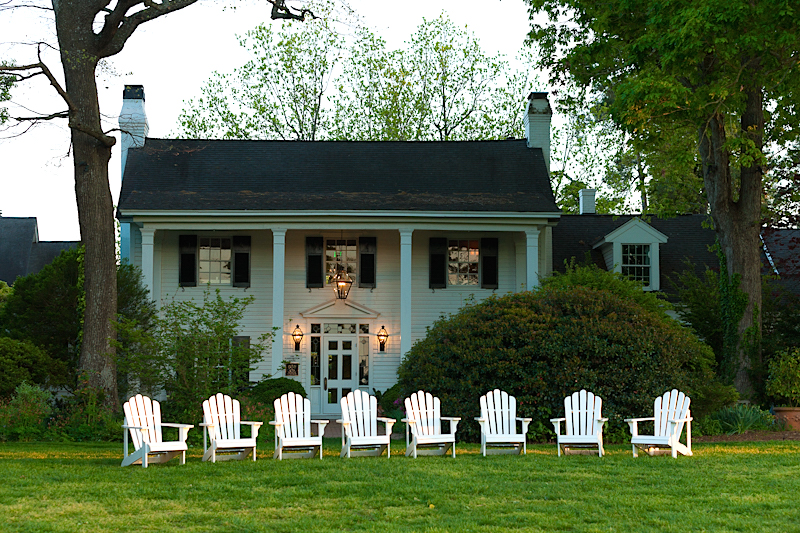
It
may someday occur to certain Southern politicians
that the greatest boost for a state’s economy and
ability to attract top talent in every field is
higher education and world-class medical centers.
And where those institutions are strong, so, too, are tourism and
good restaurants.
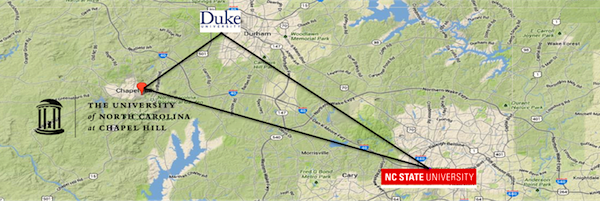 Nowhere is
this clearer than North Carolina’s great Research
Triangle--Raleigh, Durham and Chapel Hill--whose
schools (NC State, Duke and UNC) are among the most
respected in the nation, with a spill-over factor in
the hospitality industry that caters to doctors,
professors, lawyers, artists and the tourists who
visit these booming cities and partake of their
genteel form of Southern hospitality. (The
state itself is the sixth most visited in the U.S.)
Nowhere is
this clearer than North Carolina’s great Research
Triangle--Raleigh, Durham and Chapel Hill--whose
schools (NC State, Duke and UNC) are among the most
respected in the nation, with a spill-over factor in
the hospitality industry that caters to doctors,
professors, lawyers, artists and the tourists who
visit these booming cities and partake of their
genteel form of Southern hospitality. (The
state itself is the sixth most visited in the U.S.)
One of the loveliest and most
evocative places at which to experience North
Carolina culture is the Fearrington House
Inn within Fearrington Village, a
planned community of 2,000 residents in a quiet,
kempt neighborhood within the town of Pittsboro,
near Chapel Hill and about a 20-minute drive from
Raleigh/Durham Airport. The whole enterprise, now 40
years old, was built by developer R.B. Fitch and his
late wife, Jenny, who modeled Fearrington Village
after the quaint villages of England.
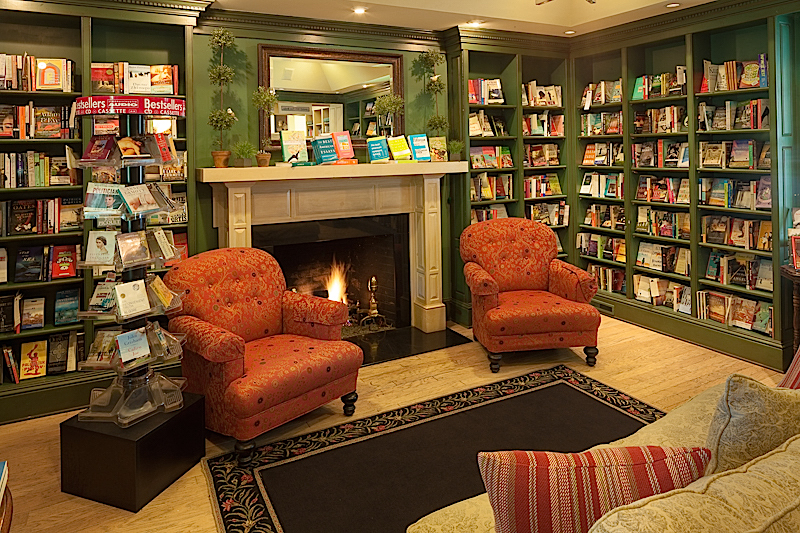
Over time the Fitches added the Roost beer garden, boutiques, a deli, McIntyre’s bookstore (right),whose Cooks & Books series has visiting authors speak and sign their work, a casual restaurant called The Granary, and an award-winning restaurant next to the Inn in the Village Center. There is also a Farmers’ Market featuring artisanal local foods and a brand new pizzeria on premises.
I had the pleasure to stay at the luxurious 32-room Inn last month, visit some of the spacious homes on the property and dine at the restaurants. I had expected my stay to be relaxing, quiet, and removed from any urban intrusions, yet I never felt "out in the boondocks" as at the reclusive Greystone Inn on Lake Toxaway in the western part of the state. I entered my suite (there are four room categories) through a courtyard garden of roses, whence come the room’s fresh flowers. The well lighted, tiled bathroom was as large as the bedroom, which was fitted out in a blend of contemporary and 19th century motifs. The living room, with a working fireplace (below), antiques, potted plants, and array of art books and style magazines, portends a high probability that you’ll slump into a long afternoon nap on the couch.
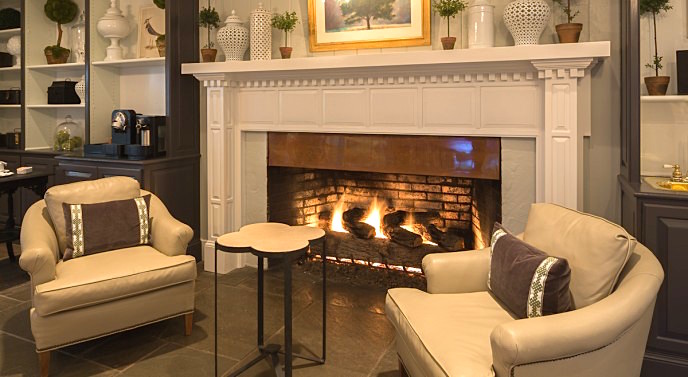
There
is free WiFi, complimentary breakfast, afternoon
tea, and at turn-down they bring a bottle of Rozès
Port and housemade chocolate truffles. The Spa is
first-rate--my long nap followed a dream-inducing
massage--while the Duke Center For Living in Durham
is an off-premises option. There are bucolic
walking trails that pass the animal enclosures,
slatted white wooden chairs dotting the lawns, and a
very rustic, large barn used for parties and wedding
receptions.
The
Granary (below),
which was in fact where grain had been stored, has a
good bar, a casual but very loud ambiance, and a far
more ambitious menu than you might think, thanks to
British-born chef Colin Bedford, who serves up
everything from sweet tea chicken wings ($6) and
smoked barbecue ribs ($11) to very good seasonal
soups ($5-$8) and a twice-baked goat’s cheese
soufflé with beets, spinach, watercress and pecans
($10). On
the pasta section, the unorthodox linguine chicken
carbonara with crispy egg, bacon jam, oyster
mushrooms and Parmesan supreme sauce ($23) is an
overwrought mess, but the fried chicken with ranch
dressing, baked 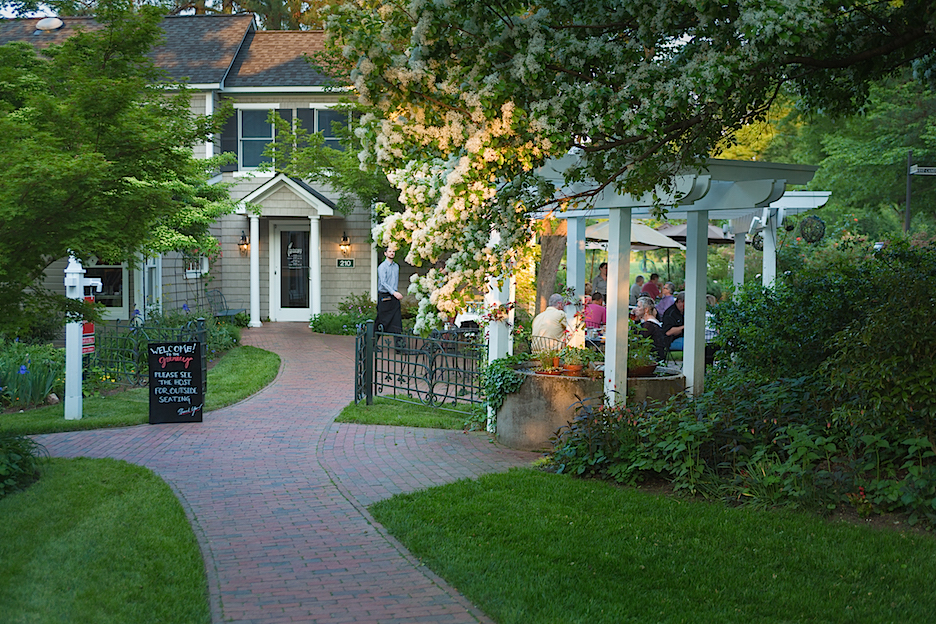 macaroni, broccolini and
garlic butter ($22) raises that Southern staple to a
new level of complementary flavors and texture. Best of
all items I tasted was grilled meatloaf with
fingerling potatoes, red cabbage, and red wine sauce
($20), another sensible elevation of downhome
cooking that shows off Bedford’s way with tradition teased by
bright new ideas.
macaroni, broccolini and
garlic butter ($22) raises that Southern staple to a
new level of complementary flavors and texture. Best of
all items I tasted was grilled meatloaf with
fingerling potatoes, red cabbage, and red wine sauce
($20), another sensible elevation of downhome
cooking that shows off Bedford’s way with tradition teased by
bright new ideas.
The Granary’s wine list, put
together by sommelier Max Kast, is remarkable for a
place this casual, as is the beer collection--with
brews from Winston-Salem, Durham and Mills River—and
the bourbon and Single Malt categories. Kast’s
real prowess, however, is shown on the award-winning
wine list of 1,500 labels and 6,000 bottles at the
fine dining Fearrington House Restaurant, which has
added a great deal of luster to the Inn’s prestige.
The
Fearrington
House Restaurant (below) is set in a series of small
dining rooms, each done in a style of an affluent
landowner whose family goes back a long ways. Neither
ornate nor colorful, except for gorgeous profusions
of flowers, the rooms are tasteful, impeccably set
with fine linens and glassware, and very graciously
overseen by general manager Theresa Chiettini and
maître d’ Joris Haarhis. I wasn’t trying to be churlish
when I asked if the room’s somber, low lighting
could be turned up just a hair, with the result that
the diners in the room all became livelier and more
engaged in the evening.
There is a great
deal of color on Bedford’s plates. He’s a
big, strapping Brit, but he has a very delicate hand
in his cuisine, and he knows well the value of
acidic counterpoint to brighten every element of a
dish, best appreciated in his $150 tasting menu or
$125 vegetarian menu.
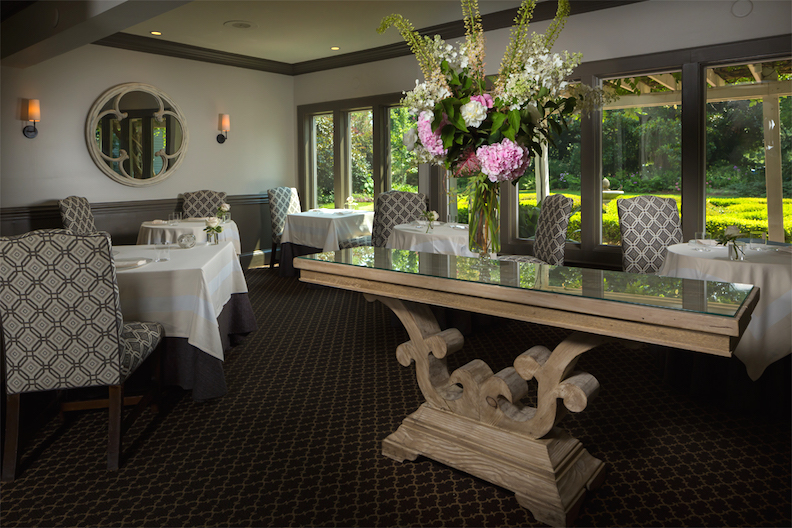 (Otherwise
three courses are $95, four $105.) To begin,
Bedford sends out beautifully composed canapés and amuses that
might include a tiny potato with hasselback roe,
sherry and mustard gels, chive crème, cheddar,
marinated pork rind, and pickled okra, or perhaps a
salad of white asparagus and flounder in a pastry
next to candied lemon jelly, smoked brown butter and
arugula.
(Otherwise
three courses are $95, four $105.) To begin,
Bedford sends out beautifully composed canapés and amuses that
might include a tiny potato with hasselback roe,
sherry and mustard gels, chive crème, cheddar,
marinated pork rind, and pickled okra, or perhaps a
salad of white asparagus and flounder in a pastry
next to candied lemon jelly, smoked brown butter and
arugula.
Bedford’s is a complex cuisine
with many elements on every plate that sometimes
hint at Modernism, like the ash that accompanies
pressed foie gras and chicken with carrots, pickled
ramps, truffle, Muscat and fava beans. However, the
less contrived, the better the food is, like a
lovely Parmesan custard with marinated asparagus,
purple sweet potato dashed with Sherry, spring
onions, sweet peas, and mustard seeds that lend
aroma to the dish.
Hamachi is cured in lemon and takes on
wonderful nuance from tea, with rhubarb avocado,
fennel and, unnecessarily, nasturtiums.
Among the
second courses that impressed me was fat quail
wrapped in prosciutto with peas and morel mushrooms,
seasoned with more mustard seeds and accompanied by
sorrel, a roast chicken cream and tang of lemon. A
delicious vegetable dish was truffled polenta--down
here called grits--with a “62-degree egg” that
softens and oozes over the cornmeal, with wild
mushrooms, sherry vinegar for spark, crushed porcini and
asparagus. The excellence of Bedford’s products is
obvious in his loin of lamb with garlic, caramelized
fennel, a touch of honey to sweeten it, goat’s
cheese to provide a creamy note, cauliflower and
baby onions. 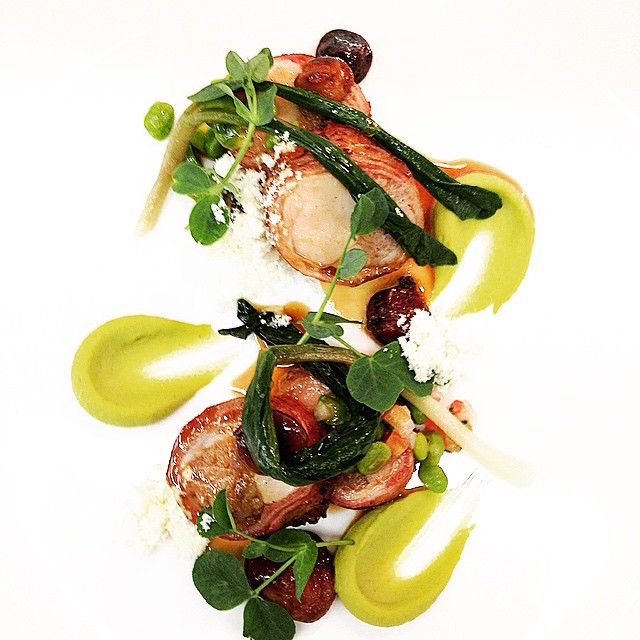
These were middle courses, for
still to come was dry-aged beef bavette with morels
and melted onions with radish, ramps and a dash of
vermouth; bacon-wrapped rabbit (right) with
Mediterranean spices and hummus; and seared halibut
with whipped potatoes and smoked avocado, malt
vinegar--that welcome acid element--and yellow split
peas.
There are pre-desserts like
“de-constructed Key lime pie,” as well as a
pre-cheese item, that night an espuma of Brie
with beets and onion. Desserts are as lavish as
everything else, including a bittersweet chocolate
ganache with Mandarin orange, almond and mint, and a
delightfully updated, very moist carrot spice cake
with brown sugar, meringue and poppy seed.
To say that Fearrington House Inn
and Restaurant is a special place is merely to lump
it with many other charming inns in America. And the
term “planned community” connotes sterile,
cookie-cutter developments like Water Color in South
Walton, FL. Fearrington
Inn is a rarer breed of refined resorts that has
given it entry into the prestigious, worldwide
Relais & Chateaux collection.
Fearrington’s
location close to the Research Triangle gives guests
easy access to the area’s attractions, and there is
certainly nothing sterile about its custom-built
homes or the working farm or the darling Village
Center, which all achieve a convenient balance of
Southern tradition and evolving contemporaneity. Both in
and out of the restaurant, there is very good taste
exhibited in every corner, every garden, the silo
and barn and bookstore, which keeps Fearrington
firmly anchored in one of the most attractive,
historic and appealing states in the South or
anywhere else in the Union.
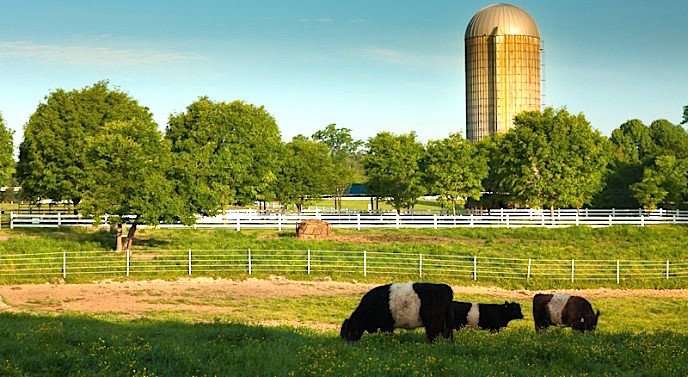
Room
rates range from $325 to $695, based on double
occupancy.
❖❖❖
By John Mariani
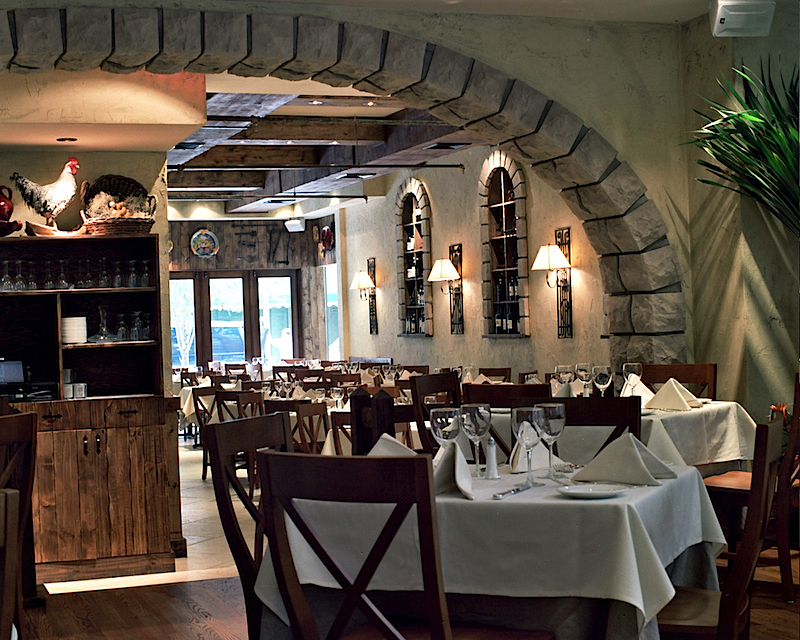 LA MASSERIA
LA MASSERIA
235
West 48th Street (off
Eighth Avenue)
212-582-2111.
lamasserianyc.com/new-york
One
peek into the dining room of La Masseria--or now, in
good weather, just a glance at the outdoor tables on
West 48th Street--shows that after eleven years it
is still one of the most popular and eminent
restaurants of any stripe in the Theater District. And,
after my recent dinner there, I find its culinary
excellence has
risen right along with its success, driven by
owners Giuseppe "Peppe" Iuele and Enzo Ruggiero with
chef-partner Giuseppe Coladonato.
The interior is as charming as
ever: rustic arched ceilings, farm utensils, photos
and artwork, aged wood, and the modernity of iron
sconces, stonework, and wine bins, all designed by
Libby Langdon. Tables are well set with linens and
delicate stemware—everything evoking the southern
Italian culture whence the owners derive.
The service staff is as well
tuned to the fast pace of the rushed pre-theater
crowd as to those who like to dine after 8 p.m. The wine
list has never been better, crammed with small
Italian producers who are thrilled to be on La
Masseria’s list.
The best way to begin here is to
share a plate of antipasti—oozing, tangy buffalo
mozzarella, slices of salumi and
sliced cheeses ($21.50), 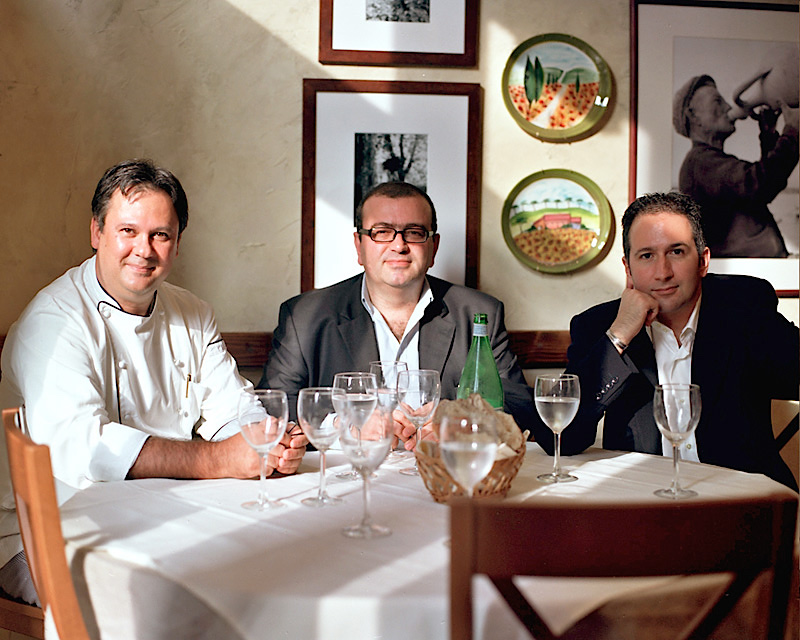 all served
at the right temperature--and the best fried strips
of zucchini ($9.50) in town, a big mound of
greaseless, thin slivers you pop in your mouth.
all served
at the right temperature--and the best fried strips
of zucchini ($9.50) in town, a big mound of
greaseless, thin slivers you pop in your mouth.
There are a good number of pastas
here (available as full or half portions) you won’t
find anywhere else, not least the granotto
($31.50)--a Pugliese grain cooked till tender like
risotto and sharing the plate with a lush seafood
sauce, mussels, and white beans--a triumph of
home-style Italian cooking! Bucatini noodles
are
mixed with a "vecchia
Roma" (old Rome) sauce of sweet onions,
pecorino and bacon ($19.50), while fresh orrechiette
alla barese comes with wonderfully
bitter-salty broccoli di rabe and Italian sausage
($22.50), and just-the-right-size potato gnocchi may
come dressed with a rich sauce of taleggio cheese,
radicchio and sprinklings of black truffles.
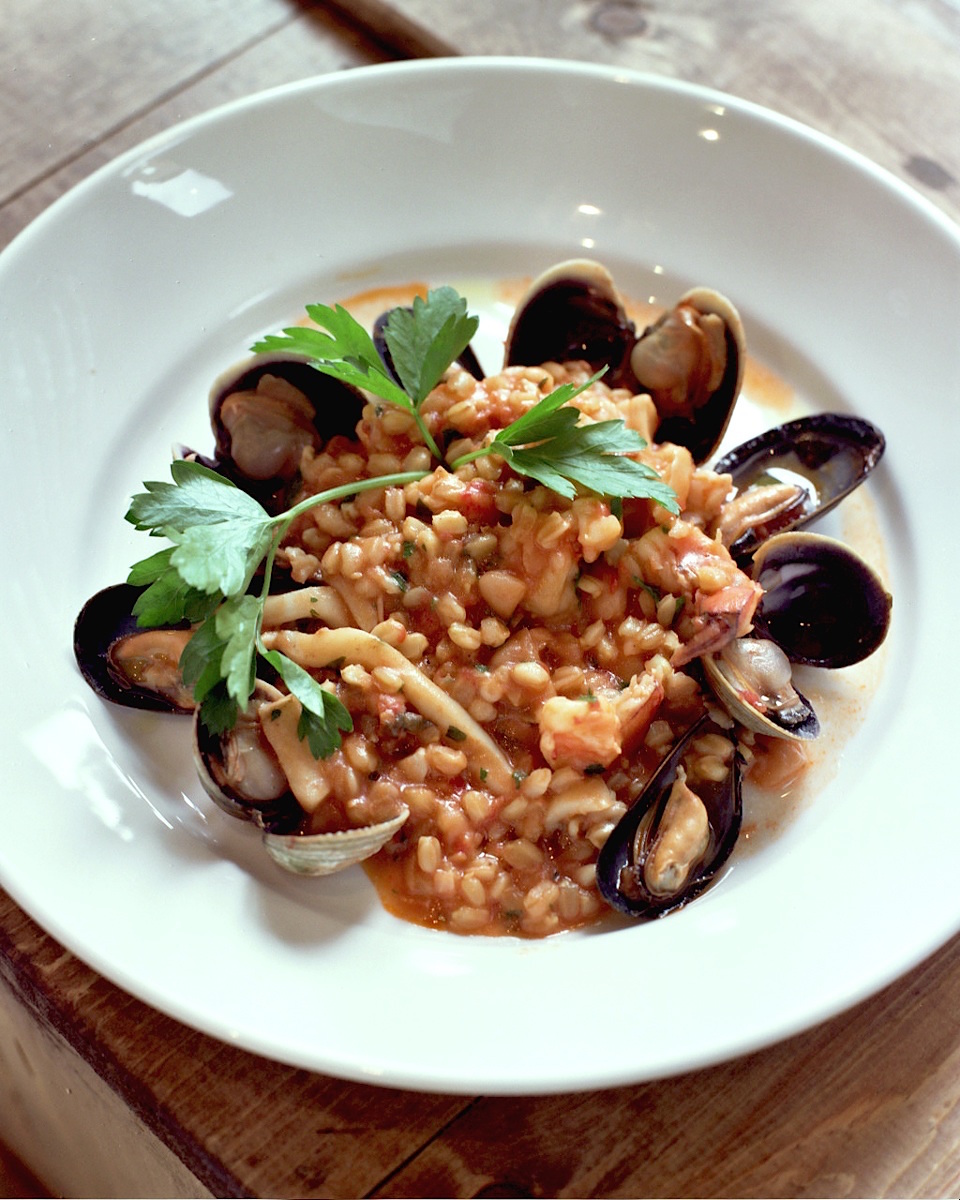 For main courses you may
go simply--as I always recommend in Italian
restaurants, especially in America--for the
impeccably grilled Mediterranean branzino, its skin
crisped and glossed with olive oil and lemon. Roast
rabbit alla
caprese with herbs and wine sauce ($32.50) is
out of the ordinary, too. Lavish in its size is a
serving of silky calf’s liver ($28.50), the ideal
balance of caramelized onions and blueberry vinegar
making this often-overcooked meat as luscious as
foie gras. La
Masseria also does one of the city’s very best
renderings of veal alla milanese
($43.50)--the pounded veal chop lightly seasoned and
perfectly sautéed to a crisp exterior and succulent
interior; as elsewhere, it is topped with an arugula
and tomato salad. A massive veal T-bone ($44.50) is
also remarkable, cooked just to the point where the
meat exudes all its flavor.
La Masseria's desserts are not
unusual, but the tiramisù ($8) is highly
recommended, especially to those who have grown
tired of this much abused Italian standard.
For main courses you may
go simply--as I always recommend in Italian
restaurants, especially in America--for the
impeccably grilled Mediterranean branzino, its skin
crisped and glossed with olive oil and lemon. Roast
rabbit alla
caprese with herbs and wine sauce ($32.50) is
out of the ordinary, too. Lavish in its size is a
serving of silky calf’s liver ($28.50), the ideal
balance of caramelized onions and blueberry vinegar
making this often-overcooked meat as luscious as
foie gras. La
Masseria also does one of the city’s very best
renderings of veal alla milanese
($43.50)--the pounded veal chop lightly seasoned and
perfectly sautéed to a crisp exterior and succulent
interior; as elsewhere, it is topped with an arugula
and tomato salad. A massive veal T-bone ($44.50) is
also remarkable, cooked just to the point where the
meat exudes all its flavor.
La Masseria's desserts are not
unusual, but the tiramisù ($8) is highly
recommended, especially to those who have grown
tired of this much abused Italian standard. 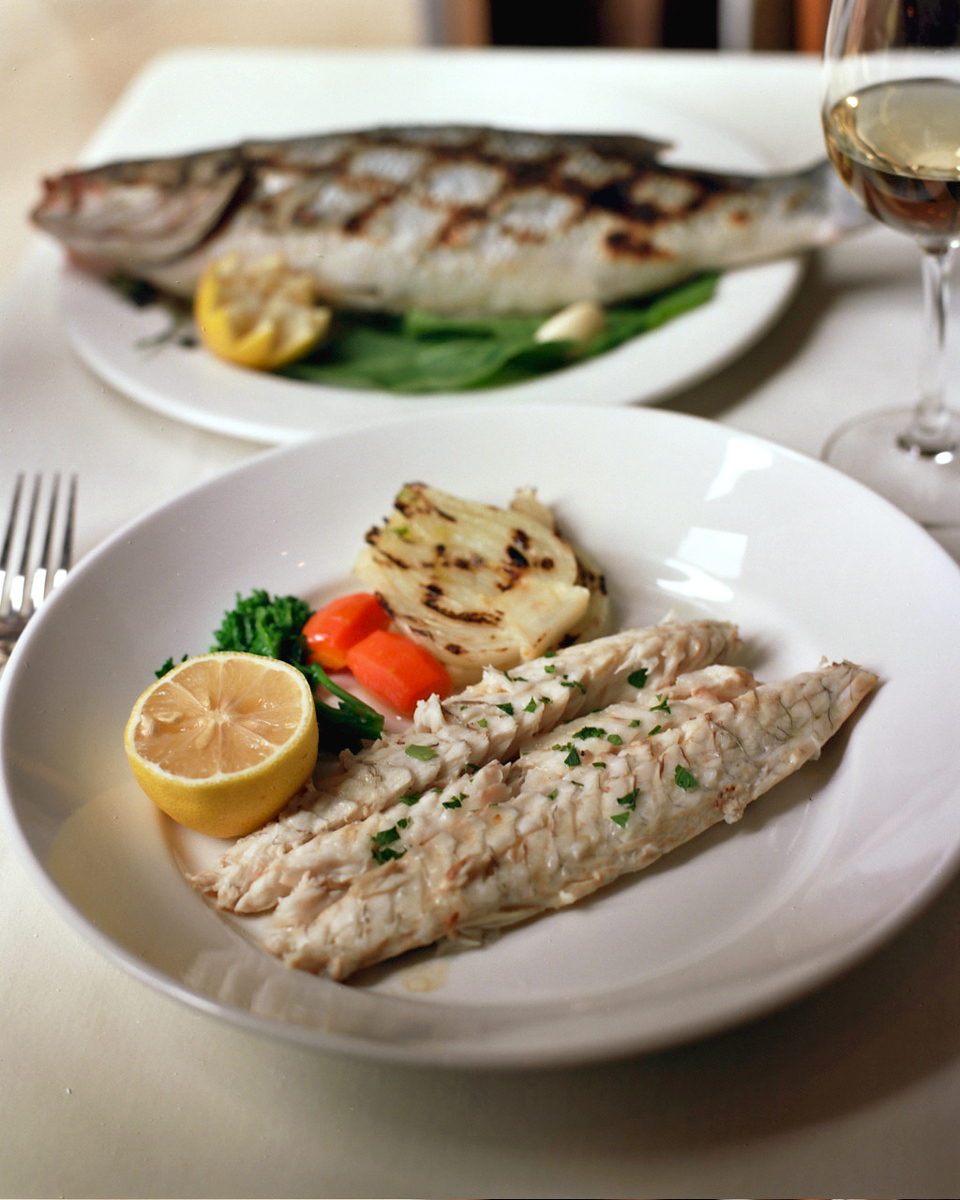 Also delicious is
the torta di
Mamma Paola ($8), a dense but moist flourless
chocolate-almond cake with vanilla ice cream, one of
the specialties of Capri. The ricotta cheesecake ($9) has
a good dose of vanilla to distinguish it from so
many insipid renditions elsewhere, and the warm
apple tart with raspberry sauce and vanilla ice
cream ($8) is worth a brief wait.
Also delicious is
the torta di
Mamma Paola ($8), a dense but moist flourless
chocolate-almond cake with vanilla ice cream, one of
the specialties of Capri. The ricotta cheesecake ($9) has
a good dose of vanilla to distinguish it from so
many insipid renditions elsewhere, and the warm
apple tart with raspberry sauce and vanilla ice
cream ($8) is worth a brief wait.
The owners have branches of La
Masseria outside of Providence, RI, and, as reported
here a few week ago, a new version called Masseria
dei Vini, near Carnegie Hall, that is every bit as
good. Keeping them all humming and packed is as much
due to the gracious hospitality shown by Signori Iuele,
Ruggiero and Coladonato as to their commitment to
their version of what Southern Italian food should
be. Faithful regulars are always assured a
great evening and newcomers will come away assured
that they have dined at one of NYC's most eminent ristoranti.
La
Masseria is located at Open daily for lunch and
dinner.
❖❖❖
ALL IN THE FAMILY AT MARTINELLI WINERY
By John Mariani
 “Honest
wines” is not a term you hear much in the arcana
of winespeak, which deals more with words like
“cigar box,” “grippy,” and “cat’s urine” to
describe what they taste. To
say a wine is honest is to be vague, but I would
most certainly apply it to the bottlings of the
Martinelli Winery, whose family has been growing
grapes in California’s Russian River Valley
since the 1880’s.
“Honest
wines” is not a term you hear much in the arcana
of winespeak, which deals more with words like
“cigar box,” “grippy,” and “cat’s urine” to
describe what they taste. To
say a wine is honest is to be vague, but I would
most certainly apply it to the bottlings of the
Martinelli Winery, whose family has been growing
grapes in California’s Russian River Valley
since the 1880’s.
I intend a double meaning: in an industry
notorious for family feuds—Gallo, Mondavi, and
others—the Martinellis are very tight knit and
dedicated to the heritage and vision of their
winery, which began when ancestors Giuseppe
Martinelli and Luisa Vellutini emigrated from
Tuscany to California looking for farmland and
start a winery, at first planting Zinfandel and
Muscat Alexandria vines on a steep, non-terraced
hillside that was later called Jackass Hill (above)
because, said their son Leno, “only a jackass
would farm a hill that steep.”
Leno retired at 89, leaving the
vineyard to his son Lee, Sr., who in 1973 took over
management of his Uncle Tony Bondi’s apple
orchards and, with his wife Carolyn, turned them
into flourishing vineyards, so that to this day,
the Martinellis still sell more grapes—about 90
percent--than are used to make their own wines.
Today, Lee Sr., his wife Carolyn, and his two
sons, Lee Jr., who left electronics for farming,
and George, who studied Agriculture at UC Davis,
keep the faith of the Martinelli family, along
with daughters Julianna and Regina, who wave the
flag in sales and marketing. 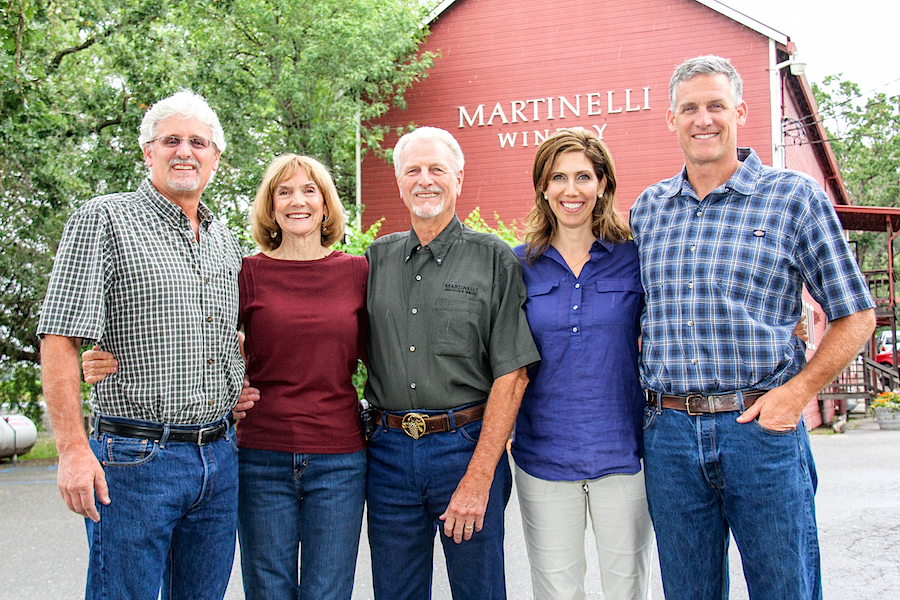
The family’s Russian River
Valley vineyards in Sonoma County, with
names like Zio Tony Ranch, Moonshine Ranch, Bondi
Home Ranch, and Giuseppe & Luisa, Vellutini
Ranch, some dating to the original plots.
“We really do handcraft our
wines,” Regina Martinelli,told me over dinner in
New York. “We hand-farm our grapes carefully from
our favorite blocks, while seeking to have the
vineyard’s special terroir shine through, which
not only makes for consistency but individuality. As much
as possible we do as little as possible during the
wine-making process, and with the longevity of our
family on this land, we know them very intimately,
and we pay attention to what the terroir tells
us.”
As a child Regina (fourth from the left)
most certainly worked the land with her family,
then transitioned into biology, company training,
and the insurance business, returning to
Martinelli Winery in 2008, where she has built up
the family's on-line business as well as holding
wine cruises and special events.
The Martinellis are certainly
not the only ones in California to claim such
commitment, though in many cases—even among
illustrious names—grapes are often purchased from
other growers.
Also, in too many cases, there is a lot
more manipulation of the grapes and wine process
back at the winery, so that the resultant wines
taste as if made to win awards rather than be
expressive of their terroir.
“We use natural native yeasts
in our fermentation, and the wines are unfiltered
and unfined,” said Regina, “which is a little
risky, but it enhances the essential flavors and
textures of the wines. We only clarify by racking
just before bottling.”
 So
when I say Martinelli’s are honest wines, I mean
that hey have not been “designed” to taste a
certain way by deliberately effecting higher
alcohol levels or by using new oak barrels to
imbue assertive flavors of sweetness and woodiness
to their wines.
Martinelli’s wines taste like wine, not
plum juice and they don’t smell like cigar boxes.
So
when I say Martinelli’s are honest wines, I mean
that hey have not been “designed” to taste a
certain way by deliberately effecting higher
alcohol levels or by using new oak barrels to
imbue assertive flavors of sweetness and woodiness
to their wines.
Martinelli’s wines taste like wine, not
plum juice and they don’t smell like cigar boxes.
Under wine maker Bryan Kvamme, who
once worked as a shepherd in Australia, The
winery currently has 25 wines in release, under 15
labels, most named after the ranch vineyard they
came from. That’s a lot of labels, probably more
than can be absorbed by the average wine drinker,
though clearly there are fans of each. I was
impressed by the Martinelli Chardonnays, which are
rich without being cloying, very light in oak, and
balanced throughout the time spent on the palate,
closer to Burgundy's Montrachets. Now three
years in repose, they’ve gained intensity without
losing vitality. They offer four of the 2011
vintage—Bella Vigna ($40), Charles Ranch ($48),
Lolita Ranch ($60), and Martinelli Road ($48)--and
the 2012 Zio Tony Ranch ($53). They are not
inexpensive Chardonnays.
Martinelli’s Syrahs, with four
in current release, differ from so many other
Sonoma wineries’ in having that spiciness of the
Rhône varietal without the alcohol barrage. Pinot
Noir has been a hard-won triumph in the Russian
River Valley, but too many producers make this
delicate varietal with far too much intensity so
that it doesn’t really taste like Pinot Noir any
more. Martinelli’s examples are far better
balanced and nuanced, which makes them so much
finer with red meats like lamb and pork, as well
as grilled salmon this summer. They
currently release five examples, with the Lolita
Ranch 2012 ($60) is especially appealing.
But
of all Martinelli’s wines I think I’m most
impressed with their Zinfandels—the first varietal
Giuseppe and Luisa planted back in the 19th
century. Zinfandel
became
America’s workhorse grape, robust enough in
tannins to impress the wine drinker who buys wine
in jug yet versatile enough to produce the white,
sweet fizzy stuff called White Zinfandel. Martinelli’s
Zins, however, respect both the tradition of the
family’s efforts to make the finest wine possible
and the technical know-how to show the varietal at
its best. Jackass Hill
($120 for the 2012), Vellutini Ranch 2012 ($52),
and well-priced Vigneto di Evo ($the 2012 is
$32)vineyards each produce good
Zinfandel—full-bodied with enormous fruit but
tannins tamed down just enough to underpin the
dark notes of the wine. Some of their Zinstop 15
percent in alcohol, but that is to be expected
with a grape that naturally bulks up with sugar. Like
Veneto’s Amarones, good California Zinfandels are
not wines to sipped before dinner, though they are
excellent with roasts, sausages, garlicky pastas,
and delicious after dinner with cheese or roasted
nuts.
The Martinellis have a long
history on their side—many California vineyards
do—but they also have a pride of family that
translates to honesty always being the best policy
when it comes to making wine.
❖❖❖

 HOLD THE PRESSES! THIS MAY BE
HOLD THE PRESSES! THIS MAY BE THE BEST NEWS OF 2015!
A new
study by the
University of Texas Health Science Center contends
drinking two or three cups of coffee a day could aid in
warding off erectile dysfunction. Drinkers of that much
coffee are almost half as likely to report "difficulty"
as men who drink lesser amounts of caffeine.
Any of John Mariani's books below may be ordered from amazon.com.
 I'm proud and happy to announce that my
new book, The Hound
in Heaven (21st Century Lion Books), has just
been published through Amazon and Kindle.
I'm proud and happy to announce that my
new book, The Hound
in Heaven (21st Century Lion Books), has just
been published through Amazon and Kindle. It is a novella, and for anyone who loves dogs, Christmas, romance, inspiration, even the supernatural, I hope you'll find this to be a treasured favorite. The story concerns how, after a New England teacher, his wife and their two daughters adopt a stray puppy found in their barn in northern Maine, their lives seem full of promise. But when tragedy strikes, their wonderful dog Lazarus and the spirit of Christmas are the only things that may bring back his master back from the edge of despair.
WATCH THE VIDEO!
“What a huge surprise turn this story took! I was completely stunned! I truly enjoyed this book and its message.” – Actress Ali MacGraw
“He had me at Page One. The amount of heart, human insight, soul searching, and deft literary strength that John Mariani pours into this airtight novella is vertigo-inducing. Perhaps ‘wow’ would be the best comment.” – James Dalessandro, author of Bohemian Heart and 1906.
“John Mariani’s Hound in Heaven starts with a well-painted portrayal of an American family, along with the requisite dog. A surprise event flips the action of the novel and captures us for a voyage leading to a hopeful and heart-warming message. A page turning, one sitting read, it’s the perfect antidote for the winter and promotion of holiday celebration.” – Ann Pearlman, author of The Christmas Cookie Club and A Gift for my Sister.
“John Mariani’s concise, achingly beautiful novella pulls a literary rabbit out of a hat – a mash-up of the cosmic and the intimate, the tragic and the heart-warming – a Christmas tale for all ages, and all faiths. Read it to your children, read it to yourself… but read it. Early and often. Highly recommended.” – Jay Bonansinga, New York Times bestselling author of Pinkerton’s War, The Sinking of The Eastland, and The Walking Dead: The Road To Woodbury.
“Amazing things happen when you open your heart to an animal. The Hound in Heaven delivers a powerful story of healing that is forged in the spiritual relationship between a man and his best friend. The book brings a message of hope that can enrich our images of family, love, and loss.” – Dr. Barbara Royal, author of The Royal Treatment.
 |
The Encyclopedia of American Food and Drink by John F. Mariani (Bloomsbury USA, $35) Modesty forbids me to praise my own new book, but let me proudly say that it is an extensive revision of the 4th edition that appeared more than a decade ago, before locavores, molecular cuisine, modernist cuisine, the Food Network and so much more, now included. Word origins have been completely updated, as have per capita consumption and production stats. Most important, for the first time since publication in the 1980s, the book includes more than 100 biographies of Americans who have changed the way we cook, eat and drink -- from Fannie Farmer and Julia Child to Robert Mondavi and Thomas Keller. "This book is amazing! It has entries for everything from `abalone' to `zwieback,' plus more than 500 recipes for classic American dishes and drinks."--Devra First, The Boston Globe. "Much needed in any kitchen library."--Bon Appetit. |
"Eating Italian will never be the same after reading John Mariani's entertaining and savory gastronomical history of the cuisine of Italy and how it won over appetites worldwide. . . . This book is such a tasteful narrative that it will literally make you hungry for Italian food and arouse your appetite for gastronomical history."--Don Oldenburg, USA Today. "Italian
restaurants--some good, some glitzy--far
outnumber their French rivals. Many of
these establishments are zestfully described
in How Italian Food Conquered the World, an
entertaining and fact-filled chronicle by
food-and-wine correspondent John F.
Mariani."--Aram Bakshian Jr., Wall Street
Journal.
"Equal parts
history, sociology, gastronomy, and just
plain fun, How Italian Food Conquered the
World tells the captivating and delicious
story of the (let's face it) everybody's
favorite cuisine with clarity, verve and
more than one surprise."--Colman Andrews,
editorial director of The Daily
Meal.com. "A fantastic and fascinating
read, covering everything from the influence
of Venice's spice trade to the impact of
Italian immigrants in America and the
evolution of alta cucina. This book will
serve as a terrific resource to anyone
interested in the real story of Italian
food."--Mary Ann Esposito, host of PBS-TV's
Ciao
Italia. "John Mariani has written the
definitive history of how Italians won their
way into our hearts, minds, and
stomachs. It's a story of pleasure over
pomp and taste over technique."--Danny Meyer,
owner of NYC restaurants Union Square
Cafe, The Modern, and Maialino.
|
 |
 |
 |
 |
 |
 |
 |
 |
 Everett Potter's Travel Report:
Everett Potter's Travel Report: 
 Eating Las Vegas
is the new on-line site for Virtual Gourmet
contributor John A. Curtas., who since 1995
has been commenting on the Las Vegas food
scene and reviewing restaurants for Nevada
Public Radio. He is also the
restaurant critic for KLAS TV, Channel 8 in
Las Vegas, and his past reviews can be
accessed at KNPR.org.
Click on the logo below to go directly to
his site.
Eating Las Vegas
is the new on-line site for Virtual Gourmet
contributor John A. Curtas., who since 1995
has been commenting on the Las Vegas food
scene and reviewing restaurants for Nevada
Public Radio. He is also the
restaurant critic for KLAS TV, Channel 8 in
Las Vegas, and his past reviews can be
accessed at KNPR.org.
Click on the logo below to go directly to
his site.

Tennis Resorts Online: A Critical Guide to the World's Best Tennis Resorts and Tennis Camps, published by ROGER COX, who has spent more than two decades writing about tennis travel, including a 17-year stretch for Tennis magazine. He has also written for Arthur Frommer's Budget Travel, New York Magazine, Travel & Leisure, Esquire, Money, USTA Magazine, Men's Journal, and The Robb Report. He has authored two books-The World's Best Tennis Vacations (Stephen Greene Press/Viking Penguin, 1990) and The Best Places to Stay in the Rockies (Houghton Mifflin, 1992 & 1994), and the Melbourne (Australia) chapter to the Wall Street Journal Business Guide to Cities of the Pacific Rim (Fodor's Travel Guides, 1991).


MARIANI'S VIRTUAL GOURMET
NEWSLETTER is published weekly. Editor/Publisher: John
Mariani.
Editor: Walter Bagley. Contributing Writers: Christopher Mariani,
Robert Mariani, Misha
Mariani,
John A. Curtas, Edward Brivio, Mort Hochstein,
Andrew Chalk, Dotty Griffith and Brian Freedman. Contributing
Photographers: Galina Dargery, Bobby
Pirillo. Technical Advisor: Gerry McLoughlin.
To un-subscribe from this newsletter,click here.
© copyright John Mariani 2015

